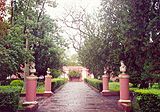
Palacio San José
Encyclopedia

Justo José de Urquiza
Justo José de Urquiza y García was an Argentine general and politician. He was president of the Argentine Confederation from 1854 to 1860.He was governor of Entre Ríos during the government of Juan Manuel de Rosas, governor of Buenos Aires with powers delegated from the other provinces...
, Argentine
Argentina
Argentina , officially the Argentine Republic , is the second largest country in South America by land area, after Brazil. It is constituted as a federation of 23 provinces and an autonomous city, Buenos Aires...
caudillo
Caudillo
Caudillo is a Spanish word for "leader" and usually describes a political-military leader at the head of an authoritarian power. The term translates into English as leader or chief, or more pejoratively as warlord, dictator or strongman. Caudillo was the term used to refer to the charismatic...
, general, politician and President of the Argentine Confederation
President of Argentina
The President of the Argentine Nation , usually known as the President of Argentina, is the head of state of Argentina. Under the national Constitution, the President is also the chief executive of the federal government and Commander-in-Chief of the armed forces.Through Argentine history, the...
from 1854 to 1860. At present, the Palace is formally the setting of the Justo José de Urquiza Museum and National Monument.
The Palace is located in the countryside, 23 km from the city of Concepción del Uruguay
Concepción del Uruguay
Concepción del Uruguay is a city in Argentina.It is located in the Entre Ríos province, on the western shore of the Uruguay River, some 320 kilometers north from Buenos Aires. Its population is about 65,000 inhabitants .-History:...
, in the province
Provinces of Argentina
Argentina is subdivided into twenty-three provinces and one autonomous city...
of Entre Ríos
Entre Ríos Province
Entre Ríos is a northeastern province of Argentina, located in the Mesopotamia region. It borders the provinces of Buenos Aires , Corrientes and Santa Fe , and Uruguay in the east....
. It was designed by architect Pedro Fossati and built between 1848 and 1858.
The Palace is a model of mid-19th century Italian-Argentine architecture. The main floor has two large courtyards surrounded by 38 rooms, as well as an archive, a library, a playroom, a large dining room, kitchens, a chapel, and two surveillance towers. One can find such luxuries as Italian marbles, French mirrors, and gold-plated roofs. The archives treasure important historical documents, antiques, paintings of Urquiza's battles, and even manifestos of ships that landed on Concepción's port. These features are very well preserved; in many cases visitors are only allowed to watch and take photographs from the outside of the rooms.
The building was the first in the country to have a complete system of running water (Buenos Aires
Buenos Aires
Buenos Aires is the capital and largest city of Argentina, and the second-largest metropolitan area in South America, after São Paulo. It is located on the western shore of the estuary of the Río de la Plata, on the southeastern coast of the South American continent...
still lacked such a system by 1870). Pipes brought the water from the Gualeguaychú River
Gualeguaychú River
The Gualeguaychú River The Gualeguaychú River The Gualeguaychú River (Spanish, Río Gualeguaychú is a river in the province of Entre Ríos, Argentina. It starts in the center-east of the province, within the Colón Department, and flows south, passing by the city of Gualeguaychú and then emptying into...
, 2 km away.
The Palace served as a political stage; here, foreign diplomats were hosted and international treaties were signed. The Apostolic Nuncio
Nuncio
Nuncio is an ecclesiastical diplomatic title, derived from the ancient Latin word, Nuntius, meaning "envoy." This article addresses this title as well as derived similar titles, all within the structure of the Roman Catholic Church...
, military leaders and important politicians were also received here.
Urquiza was assassinated in the Palace on the night of 11 April 1870 by followers of Ricardo López Jordán
Ricardo López Jordán
Ricardo Ramón López Jordán was an Argentine soldier and politician, one of the last influential "caudillos" in the history of Argentina...
, a federal dissident. The bloodied prints of Urquiza's hand are preserved in the room where this took place, which was then turned into an oratorium by his wife.
The Palace was declared National Monument by law on 30 August 1935.
Sources
- Palacio San José - Official website (in Spanish)
- Museos Argentinos
- Argentina invisible (in Spanish)

